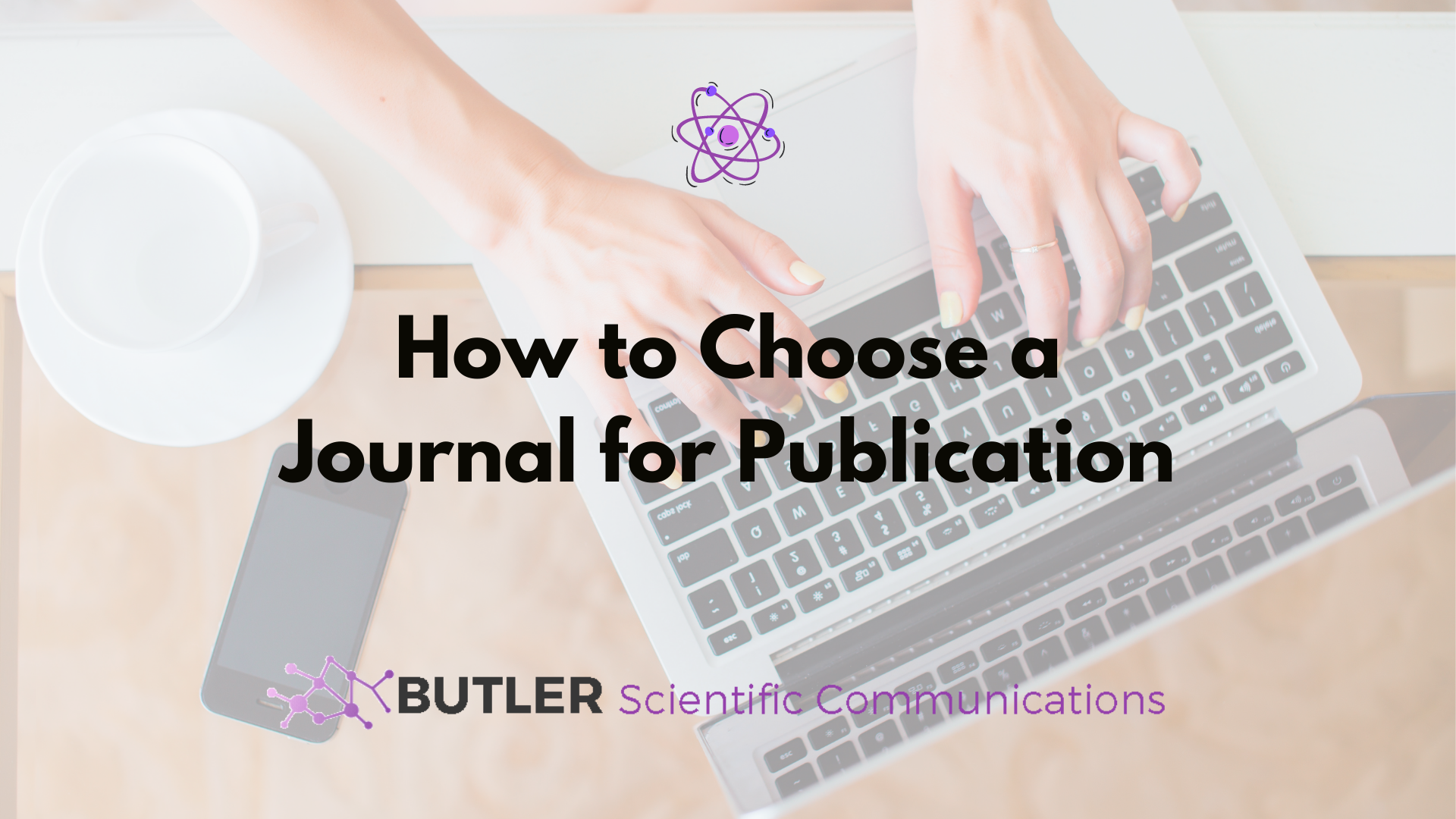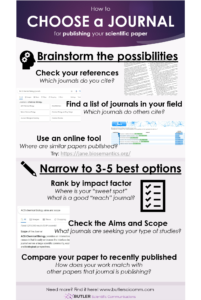We talk a lot on this site about writing your scientific manuscript, but not yet about how to choose a journal for publication after your manuscript is written.
Just like writing a manuscript, selecting where to submit that manuscript is something that is rarely covered for graduate students, and picking a good place to submit becomes another sink-or-swim situation. Because so much work goes into preparing an article for a target audience and preparing a new, individual cover letter for each submission, picking the wrong journal can add a lot of extra work – not to mention the added stress from unnecessary rejections!
Fortunately, this process doesn’t have to be difficult, and there are some simple steps you can take to narrow down your options. To find the best journal for your paper, I am going to first walk you through how to brainstorm a list of options and then how to narrow down those options to your final list.
As usual lately, if your prefer your content in video form, you can find it here:
Brainstorming your journal options
We’re first going to start our journal selection process by brainstorming a list of possible journals. Especially if you are new to choosing a journal for publication, don’t worry too much about weighing the options at first and just get a list of possibilities down on paper.
Use these three steps to help you brainstorm:
1. Check the journals you most commonly cite
The first and easiest method to choose your journal for publication is to look at the references of your paper. This will help you find journals that closely align with the scope of your work and are often a great option for your submission as you know they are looking for similar things.
The journals you find from this exercise should therefore rank highly in your list of possible options.
If you have already written a draft of the paper you are going to submit, just go to your reference section and make a list of each journal you cited and how many times you cited it. This is usually a great way to see where the type of work you are doing falls in terms of journal scope and can make a good starting list.
If you haven’t written your draft yet – never fear! You can still do this exercise! Instead, look at the references of the last manuscript your lab wrote or published on this topic.
2. Search for the most common journals in your field
After first looking at the specific journals that match your work, you can expand your search more generally to the field.
I suggest googling for a list of the most popular or best journals in your field, which you can generally find with a quick search. For example, take this search for journals in chemical biology:
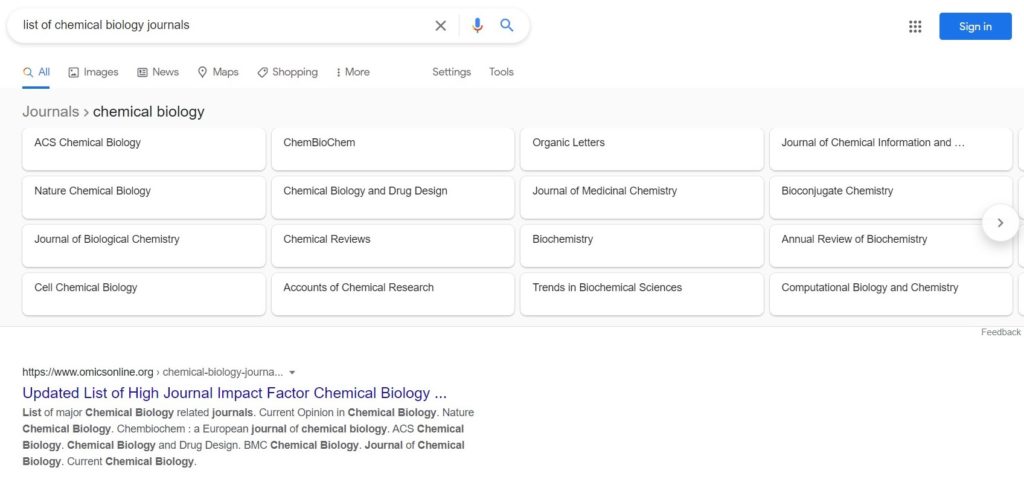
This quick search pulled up both an extensive list of journals in chemical biology as well as links that actually rank these journals for impact factors and other metrics.
By doing this exercise, you might find some journals that you didn’t cite in your paper. Here, though, you will want to weigh these options more carefully, as the scope may not be as close of a match to your work and the impact factor might differ from what your goal.
3. Use an online tool
Finally, great online tools exist for helping choose a journal for publication.
My recommendation is the Journal/author name estimator (https://jane.biosemantics.org/), wherein you input your working title and can see an output of possible journal options.
As an example, I inputted the title of a recently published work to see this output:
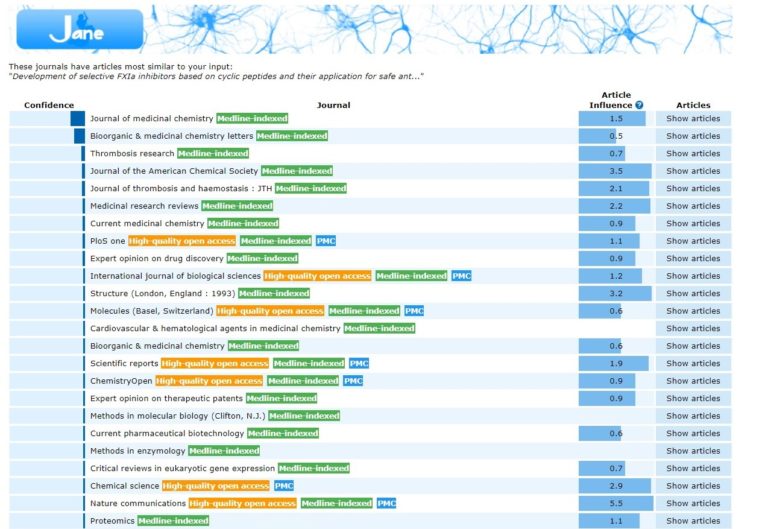
Here, the tool picked up on the journal it was published in as well as a list of similar journals that would also make good options for this work.
As this tool might be the least related to your work and field and does rely only on the title (which may or may not be an accurate reflection of your work), do weigh these options carefully. This is a great way to generate ideas for where to publish, but make sure your work will fit the scope of the journals.
->As a bonus, you can also use this tool for finding possible referees for your work or other similar articles you can cite.
Narrowing the list
Now that we have a list of possible places to publish our paper, we are going to apply a few strategies for narrowing this list.
4. Rank by impact factor (or another numerical metric)
One of the easier ways to narrow down your journal list is checking the impact factors of the different journals that you brainstormed. This is an easy-to-find metric that you can often get from one simple webpage, especially if you found a list of journals in your field ranked by impact factor.
Here, you will be able to order your list based on this factor, as it can serve as a (rough) metric for how selective the journal will be.
Don’t choose where to publish your journal just from this, though – this will help you narrow, but there are better reasons to publish somewhere…
5. Check the aims and scope page
One of the best ways for choosing a suitable journal for your work is to check the aims and scope page of each journal to find the ones that most match with your project.
To do this, all you need to do is Google the name of the journal and “aims and scope”, which I have done here for ACS Chemical Biology:
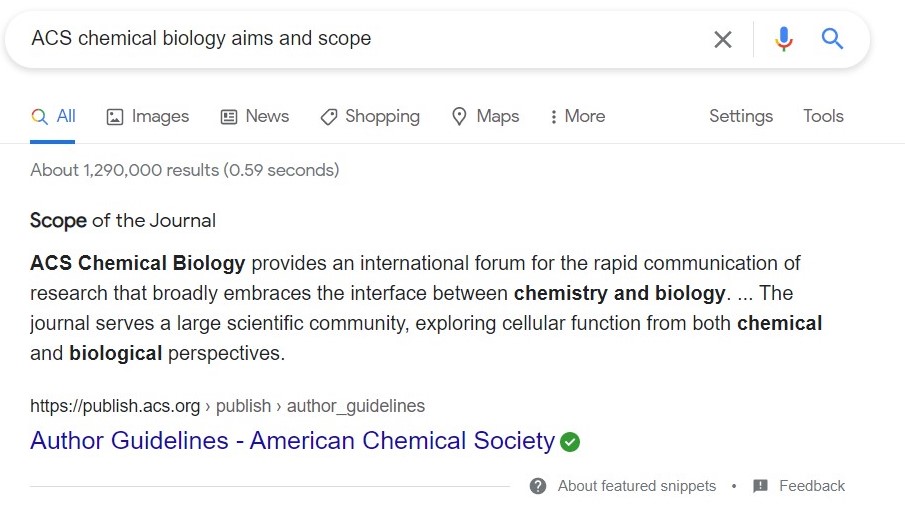
From this description, we can see that they are seeking to publish work that explores cellular function from both a chemical and biological perspective. This is very useful, as it is a rather specific body of work they are seeking, and you will either have this in your project or you will not.
In the end, it is never worth your time or the journal editor’s time to submit work that falls outside of the scope of a journal, so any journal with aims that don’t match your work should be automatically excluded from your list.
6. Compare to other papers published by that journal
By this point, you should be forming a good idea of what journals you will want to aim for.
I suggest now putting together your final list of 3-5 possible options, ranked according to the likelihood of acceptance. I like to find my “solid” options – ones where I really think I have a good chance of getting my work published, as well as a “long shot” journal that is maybe higher than where I think my work might land, but is still close enough or a good enough journal to be worth the try.
To find where your work might fall on your list of journals ranked by impact, now you will need to dig a bit deeper into these journals to find what types of work they are publishing.
Look at articles in that journal that might be similar to yours. Ask yourself:
- What types of studies are these? How similar is my type of study to what they are publishing?
- What types of experiments are others doing to get into these journals? Do I have the same types of experiments?
- How extensive are the experiments done by other papers? Did they do a few studies in a narrow field, or are most papers published here extensive containing a broad range of work in each publication?
- How broadly reaching are the conclusions drawn from this paper? Is my paper in the same scope of how much it affects the field?
- How broad of an audience are the other papers aimed towards? Is the work published here generally understandable to wide audiences, or is it written to field-specific audiences?
By going through and asking these questions, you can see where your work falls in the range of what is published in the different journals and can solidify your short list of where you will be submitting your work.
Additionally, by having a list of more than one journal, you can avoid the disappointment that comes from picking one journal and having your paper rejected – which is always a possibility! You never know what the journal is looking for that day or how many other papers have recently been accepted.
Infographic
To put all of this together for you, here is a helpful infographic you can save and keep close for future reference. Click the image to enlarge.
Ok, so what’s next?
After you choose a journal for publication, there are still a few important steps you will want to take.
First, ensure the writing of your paper matches that of the TOP journal you will be submitting to. This journal will have the broadest audience and will need to be the most accessible, and a paper written for a field-specific journal will likely not pass the initial submission process.
Ensure your work is accessible to the broadest audience you will be submitting to – a journal written for a broad audience is still great to submit in a more field-specific journal, but the opposite is not true!
Second, you will need to write a cover letter for submitting your work. Luckily, we have you covered there!
Go here to read about what NOT to do in your cover letter.
Go here to read about the ideal formula for a cover letter and how to write yours.
Hopefully now you have an idea of where to publish your work and are well on your way to submission!
Best of luck, and let us know how it goes in the comments.
